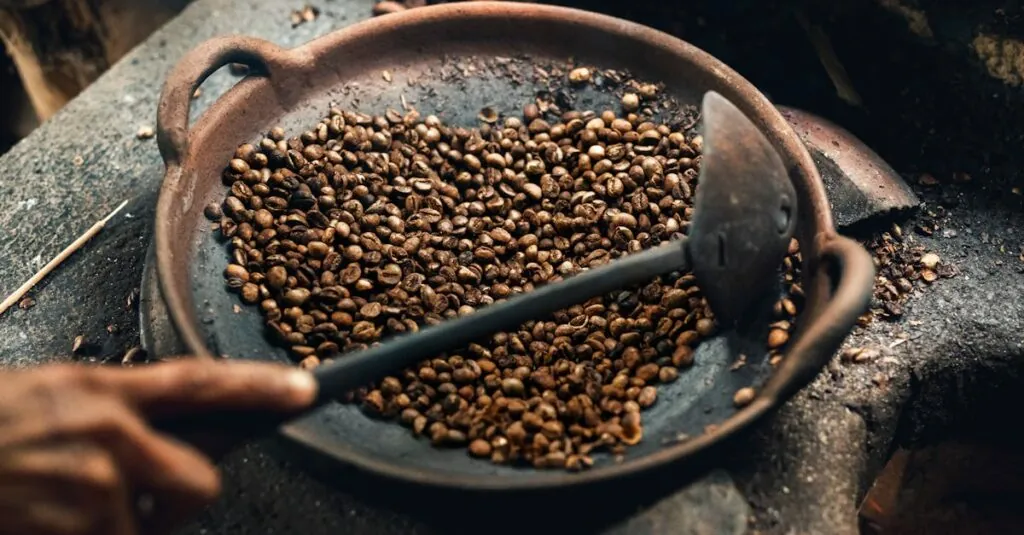Table of Contents
ToggleCooking is more than just a way to prepare food; it’s an art form that can elevate the ordinary to the extraordinary. Whether you’re a novice in the kitchen or a seasoned chef, understanding various cooking methods can turn a simple meal into a culinary masterpiece. From the sizzle of a hot grill to the gentle simmer of a stew, each technique brings its own flavor and flair.
Overview of Methods of Cooking Food
Cooking encompasses various techniques that elevate the food preparation experience. Methods such as boiling, roasting, and frying serve distinct purposes while enhancing flavors.
Boiling involves cooking food in water or broth at high temperatures. This method often keeps nutrients intact, making it ideal for vegetables like carrots or potatoes.
Roasting utilizes dry heat, whether from an oven or open flame, to create a caramelized exterior. Meats like chicken or beef benefit from this method as it intensifies flavors and tenderness.
Frying, divided into shallow frying and deep frying, adds crispiness that many enjoy. Ingredients like onion rings or fish fillets develop a golden crust that enhances both texture and flavor.
Grilling relies on direct heat, imparting a smoky taste. Foods such as burgers or vegetables develop char marks, adding visual appeal and a unique flavor profile.
Steaming maintains moisture and nutrients by cooking food with steam. This method is particularly effective for delicate items like fish or broccoli, preserving their integrity.
Baking is a slow cooking method, often used for bread, pastries, and casseroles. Even heat from an oven ensures thorough cooking while achieving a desirable texture.
Sautéing quickly cooks food in a small amount of oil or fat over high heat. This method works well for items like bell peppers or shrimp, allowing for speedy preparation while preserving crispness.
Each method showcases the versatility and creativity inherent in cooking, allowing both beginners and experts to craft remarkable dishes. By exploring these techniques, cooks can unlock new flavors and textures in their culinary creations.
Dry Heat Cooking Methods
Dry heat cooking methods use direct heat to cook food without added moisture. These techniques enhance flavor and texture while preserving nutrients.
Baking and Roasting
Baking involves cooking food using dry heat in an enclosed space, typically an oven. This method suits a wide range of dishes like bread, pastries, and casseroles. Roasting applies similar heat but often targets meats and vegetables, achieving a caramelized outer layer. It enhances flavors through browning, resulting in complex tastes. Temperature plays a crucial role; typical baking temperatures range from 350°F to 450°F. Roasting often occurs at higher temperatures, around 400°F to 500°F, to develop that rich flavor.
Grilling and Broiling
Grilling cooks food over direct heat, usually on a grill or an open flame. Meats, vegetables, and fish benefit from this method, gaining distinctive charred flavors. Charcoal and gas grills provide different tastes, enhancing the grilling experience. Broiling offers a similar outcome but involves cooking food under an intense top heat source, often in an oven. This technique quickly browns food, improving textures while sealing in juices. Grilling temperatures typically range from 300°F to 500°F, while broiling often happens around 500°F to 550°F for optimal caramelization.
Moist Heat Cooking Methods
Moist heat cooking methods incorporate water or steam to cook food, promoting tenderness and flavor retention.
Boiling and Simmering
Boiling involves cooking food in water or broth at temperatures of 212°F. Long pasta, vegetables, and eggs benefit from this method. Simmering operates at lower temperatures, usually 180°F to 205°F, allowing flavors to develop gradually. Soups, sauces, and grains typically utilize this technique. Both methods effectively soften foods and can preserve nutrients when cooking times are kept short. Overcooking may lead to nutrient loss or textural degradation.
Steaming
Steaming cooks food using steam generated from boiling water, preserving nutrients and flavors. This method typically employs a steamer basket or an electronic steamer. Vegetables like broccoli and carrots often retain their bright colors and crisp textures, enhancing their appeal. Cooking times vary depending on the food type, ranging from 5 to 15 minutes for most vegetables. Fish and dumplings also thrive with steaming, resulting in moist, tender dishes without added fats.
Combination Cooking Methods
Combination cooking methods blend techniques to maximize flavors and textures. This approach often involves using both moist and dry heat methods for optimal results.
Braising
Braising involves cooking food slowly in a small amount of liquid, typically at low temperatures, for extended periods. It often starts with searing the meat or vegetables in a hot pan to develop rich flavors. After browning, the food is submerged partially in liquid, such as broth or wine, and then covered for a slow cooking process. This technique is ideal for tougher cuts of meat, as it breaks down collagen and results in tender dishes, like braised short ribs or coq au vin. Cooking temperatures generally range from 300°F to 325°F, making braising a method that allows flavors to meld beautifully.
Stewing
Stewing is similar to braising but usually involves smaller, bite-sized pieces of meat or vegetables cooked in a larger quantity of liquid. This method ensures thorough flavor infusion as the ingredients simmer together. Typically, stewing liquid can include stocks, sauces, or tomatoes, which add depth to the dish. Stewing cooks food gently at temperatures around 180°F to 205°F, allowing flavors to develop while keeping ingredients moist and tender. Comforting dishes like beef stew or vegetable curry showcase the effectiveness of this technique. Stewing not only enhances taste but also provides a warming meal, perfect for gatherings.
Cooking with Special Techniques
Exploring special cooking techniques elevates culinary skills and creates unique flavors. Two notable methods are sous vide and smoking.
Sous Vide
Sous vide involves sealing food in a vacuum bag and cooking it in a water bath at consistent low temperatures, typically between 120°F and 185°F. This precision allows for even cooking and exceptional tenderness. Proteins like steak or chicken become perfectly cooked from edge to edge. With sous vide, retaining moisture and natural flavors becomes straightforward, resulting in a restaurant-quality texture. Cooking times can vary; for instance, steaks may require 1 to 4 hours based on thickness. Chefs often finish sous vide dishes with a quick sear to enhance flavor and presentation.
Smoking
Smoking introduces a distinct flavor profile to various foods by exposing them to smoke from burning or smoldering materials, usually wood chips. Different woods, such as hickory or applewood, impart unique tastes. This method generally requires low temperatures, ranging from 225°F to 275°F, and longer cooking times, often 2 to 12 hours. Meats, particularly brisket, ribs, and fish, benefit greatly from this slow process, infusing deep, rich flavors. Various types of smoking, including hot and cold smoking, cater to specific dishes and desired outcomes, showcasing the versatility of this technique in flavor enhancement.
Exploring different cooking methods opens up a world of culinary possibilities. Each technique brings its own unique flavors and textures to the table, allowing cooks to express their creativity. Whether someone prefers the simplicity of boiling or the intricacies of sous vide, mastering these methods enhances the overall cooking experience.
Experimenting with various techniques not only improves skills but also transforms ordinary meals into exceptional dishes. Embracing the art of cooking encourages individuals to discover new tastes and enjoy the journey of creating memorable meals for themselves and their loved ones.







